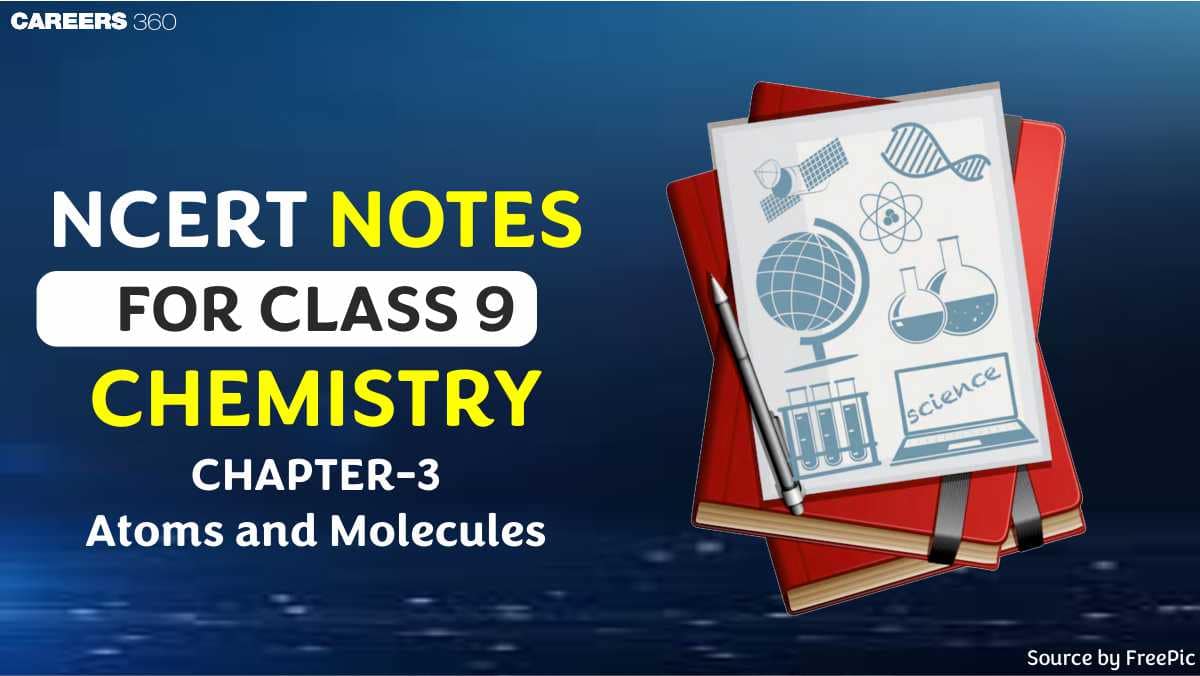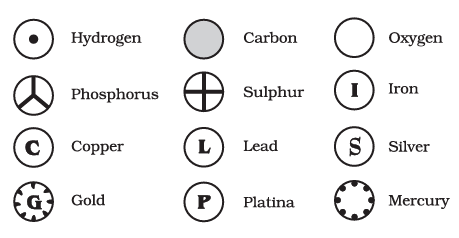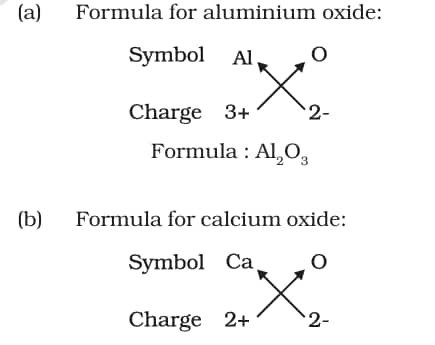Aakash Repeater Courses
ApplyTake Aakash iACST and get instant scholarship on coaching programs.
Have you ever wondered how things around us are made? Like the air we breathe, the phone we are currently using to read this article, or the food we eat daily to quench our appetite. The answer to all those questions is atoms and molecules. Atoms are the smallest unit of matter while molecules are made up of a combination of two or more atoms and they are so small that we cannot see them from the naked eye; to see them we require a high-end microscope.

The Topics like laws of combinations, atomic mass, molar mass etc. are covered in this chapter. The NCERT Notes for Class 9 Science chapter 3 are prepared in a systematic way to give you detailed information on the structure and behaviour of atoms and molecules. These NCERT notes will not only help you in exams but will also strengthen your fundamentals in chemistry. The important formulas and diagrams also also included to give you a clear picture.
Also read
You can download class 9 chapter 3 Atoms and molecules notes in the PDf from for easy access from the download icon given below:
The notes contain all the topics in detail with appropriate examples. Students can use them as a handbook for learning and revision of the concepts. Scroll down to know more!
An Indian philosopher, Maharishi Kanad, said that if we go on dividing matter (padarth), we will get smaller and smaller particles of matter. Ultimately, we will get the smallest particle of matter, which cannot be divided any further. Based on this philosophy, Kanad was one of the first persons to propose that matter (or padarth) is made up of very small particles called ‘parmanu’. John Dalton called these particles by the name of atom. The word ‘atom’ means ‘indivisible’; something which cannot be divided further.
Another Indian philosopher Pakudha Katyayama went a step further and proposed that the particles of matter (atoms or parmanu) normally exist in a combined form and various combinations of particles give us various kinds of matter. This combined form of atoms is now called ‘molecules’.
We now know that all matter is made up of small particles called atoms and molecules. Different kinds of atoms and molecules have different properties due to which different kinds of matter also show different properties. Thus, the properties of matter depend on the properties of atoms and molecules from which it is made. Democritus explained that if we keep on dividing matter, we will end up with its smallest unit, which won’t be divisible further and he named it an atom.
Antoine L. Lavoisier is called the father of chemistry, for he gave two important laws of chemical combination which laid the foundation of chemical sciences, and the laws are as follows:
It states that “Mass is not created and not destroyed, in a chemical reaction”. The substances which combine together (or react) in a chemical reaction are known as 'reactants’ whereas the new substances formed (or produced) as a result of chemical reaction are called ‘products’. There is no change in mass during a chemical reaction. Since there is no gain or loss in mass in a chemical reaction, the mass remains conserved.
For example,
“The elements are present in definite proportions by mass in a chemical substance.” This law means that whatever be the source from which it is obtained (or the method by which it is prepared), a pure chemical compound is always made up of the same elements in the same mass percentage.
For example, water is a compound that always consists of the same two elements, hydrogen and oxygen, combined together in the same constant proportion of 1 : 8 by mass (1 part by mass of hydrogen and 8 parts by mass of oxygen).
Dalton’s Atomic Theory
The theory that ‘all matter is made up of very tiny indivisible particles (atoms)’ is called atomic theory of matter. Dalton put forward his atomic theory of matter in 1808.
The postulates of the theory are given below:
“Matter is made of very small particles called atoms”.
“Atoms are not divisible particles, which are not created and not destroyed in a chemical reaction”.
“Atoms of the same element have identical mass and chemical properties”.
“The chemical properties of the atoms are different for different elements.”.
“Compounds are formed by combining atoms of different elements in ratios of small whole numbers”.
An atom is the smallest unit of matter that retains all of the chemical properties of an element. For example, a gold coin is simply a very large number of gold atoms molded into the shape of a coin, with small amounts of other, contaminating elements. Gold atoms cannot be broken down into anything smaller while still retaining the properties of gold. A gold atom gets its properties from the tiny subatomic particles it's made up of.

An atom consists of two regions. The first is the tiny atomic nucleus, which is in the center of the atom and contains positively charged particles called protons and neutral, uncharged, particles called neutrons. The second, much larger, region of the atom is a “cloud” of electrons, negatively charged particles that orbit around the nucleus. The attraction between the positively charged protons and negatively charged electrons holds the atom together.
The size of an atom is indicated by its radius which is called ‘atomic radius’. Atomic radius is measured in ‘nanometres’ (which is a very small unit of measuring length). The symbol of a nanometre is nm.
Hydrogen atom is the smallest atom of all. The atomic radius of a hydrogen atom is 0.037 nanometre (or 0.037 nm). If we express the radius of a hydrogen atom in metres, it will be 0.037 × 10–9 metre which means 0.000000000037 metre ! It is really very, very small. The atomic radii of some common elements are given below:
The relative size of different matters:
|
Radii (m) |
Example |
|
|
Atoms of hydrogen |
|
|
Molecules of water |
|
|
Molecules of haemoglobin |
|
|
Grain of sand |
|
|
Ant |
|
|
Watermelon |
Dalton was the first scientist to use the symbols for elements in a very specific sense.

Now-a-days, IUPAC (International Union of Pure and Applied Chemistry) is an international scientific organisation which approves names of elements, symbols and units. Many of the symbols are the first one or two letters of the element’s name in English. Some elements and their symbols:
|
Element |
Symbol |
|
Hydrogen |
H |
|
Helium |
He |
|
Lithium |
Li |
|
Sodium |
Na |
|
Gold |
Au |
|
Silver |
Ag |
|
Mercury |
Hg |
|
Iron |
Fe |
|
Chlorine |
Cl |
It is the number of protons present in an element.
It is the number of protons and neutrons present in an element.
Carbon-12 isotope is the standard reference for calculating atomic masses of other elements. One atomic mass unit is a mass unit equal to one-twelfth (1/12th) the mass of one atom of carbon-12.
Atoms of most elements are not able to exist independently. Atoms form molecules and ions.
A molecule is an electrically neutral group of two (or more) atoms chemically bonded together. The forces which hold the atoms together in a molecule are called covalent bonds. Thus, a combination of atoms is called a molecule. A molecule is the smallest particle of a substance (element or compound) that has the properties of that substance and can exist in the free state. Molecules can be formed either by the combination of atoms of the ‘same element’ or of ‘different elements.
Depending on this, there are two types of molecules : molecules of elements, and molecules of compounds. This is discussed below.
The molecule of an element contains two (or more) similar atoms chemically combined together. For example, a molecule of hydrogen element contains 2 hydrogen atoms combined together, and it is written as H2. Some similar examples include nitrogen gas exists as N2 molecules, oxygen gas as O2 molecules and chlorine gas as Cl2 molecules.

The molecule of a compound contains two (or more) different types of atoms chemically combined together. For example, hydrogen chloride(HCl) and water(H2O).

It is a group of two or more elements held together in a chemical bond by attractive forces.
The number of atoms in a molecule is called the atomicity of the molecule.
An ion is a charged particle; it can be positively charged or negatively charged. Positively charged ions is called ‘cation’ and negatively charged ion is called ‘anions’.
Sodium ion (Na+) and magnesium ion (Mg2+) are cations because they are positively charged ions. A cation is formed by the loss of one or more electrons by an atom. For example, sodium atom loses 1 electron to form a sodium ion, Na+, which is a cation :
Similarly, Chloride ion (Cl–) and oxide ion (O2–) are anions because they are negatively charged ions. An anion is formed by the gain of one or more electrons by an atom.
It is a symbolic representation of a compound and its composition.
Given below are the rules for writing a chemical formula:
The charges on the ions have to balance each other.
If the compound contains a metal and a nonmetal, the metal is written first.
For example: sodium chloride (NaCl), where chlorine is a non-metal, so written on the right, and sodium is a metal, so written on the left.
In compounds with polyatomic ions, the ion is enclosed in a bracket and then the number of the ion is indicated. If number of polyatomic ion is one, the bracket is not required.
For example:

The molecular mass of a substance is equal to the sum of the atomic masses of all the atoms in that molecule.
If the substance contains ions as its constituents, then the molecular mass is called Formula Unit Mass.
Formula unit mass is calculated in the same manner as we calculate the molecular mass. The only difference is that we use the word formula unit for those substances whose constituent particles are ions.
For example, sodium chloride as discussed above, has a formula unit NaCl. Its formula unit mass can be calculated as 1 × 23 + 1 × 35.5 = 58.5 u
Question 1. Which of the following is the correct representation of one mole of a substance?
A)
B) 12 g of carbon-12
C) 1 g of hydrogen gas
D) 22.4 g of nitrogen gas
Answer: B) 12 g of carbon-12
By definition, 1 mole
Hence, the correct answer is option (2).
Question 2. What is the mass of 0.5 mole of
A) 8 g
B) 16 g
C) 32 g
D) 48 g
Answer: B) 16 g
Molar mass of
So, mass
Hence, the correct answer is option (2).
Question: Which of the following is the correct chemical formula for magnesium chloride?
A. MgCl
B.
C.
D.
Answer:
Magnesium has a valency of +2, and chlorine has a valency of -1, so two chloride ions are needed to balance one magnesium ion which will give the formula
Hence, the correct answer is option (2).
The links in the table below will provide you chapter-wise NCERT notes
Click on the links below to excel your exam preparations by solving NCERT exemplar solutions.
The links below are for the NCERT solutions that will help you in your preparations.
A chemical formula represents the composition of a molecule of a compound.
It shows:
Example:
H₂O → 2 atoms of hydrogen and 1 atom of oxygen in one molecule of water.
To determine the molecular formula
Know the elements present and their valencies.
Cross-multiply valencies to balance charges (criss-cross method).
Simplify the ratio to the lowest whole numbers.
Example:
Magnesium valency = 2, Chlorine valency = 1
→ MgCl₂ is the formula after cross-multiplying valencies.
A polyatomic ion is a group of two or more atoms that are covalently bonded, but act as a single ion with a net charge.
Examples:
The main postulates of Dalton atomic theory are :
Atoms are the smallest unit of matter. Everything around us is made up of atoms. An atom has 3 main parts which are electrons, protons and neutrons.

Take Aakash iACST and get instant scholarship on coaching programs.

This ebook serves as a valuable study guide for NEET 2025 exam.

This e-book offers NEET PYQ and serves as an indispensable NEET study material.

As per latest syllabus. Physics formulas, equations, & laws of class 11 & 12th chapters
As per latest syllabus. Chemistry formulas, equations, & laws of class 11 & 12th chapters
As per latest 2024 syllabus. Study 40% syllabus and score upto 100% marks in JEE